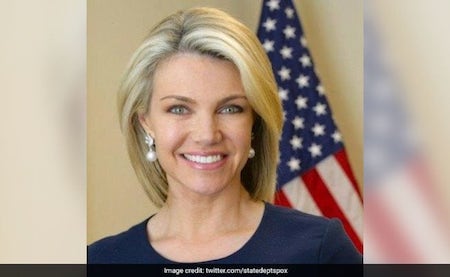
China is willing to respond positively to US moves towards a limited détente
“The US is vulnerable as it is involved in two wars, one in Europe and the other in West Asia. While it is engaged in a rivalry with China in the Indo-Pacific, there is as yet no ‘hot war’ there and the US would prefer to keep a lid on that possibility. For this to work, there must be a lessening of tensions with China. China faces its own economic headwinds and is willing to respond positively to US moves towards a limited détente. Public expressions of an anti-China front with India would run counter to this. The postponement of the New Delhi Quad summit, which would have brought President Biden to India, points in the same direction — of not alienating China at this critical juncture.”

When India and the US concluded the historic Civil Nuclear Agreement in 2008, their bilateral relations were launched on a positive trajectory. Since then, there has been an across-the-board expansion in virtually all dimensions of the relationship — security, technology, defense, economy and commerce. There is today a broader and deeper relationship of unprecedented magnitude. This is undoubtedly anchored in enduring strategic convergence, particularly with respect to maintaining a balance of power in the Indo-Pacific but not limited to it. If there is a ‘quadrilateral’ platform which groups India together with the US and its military allies Japan and Australia in the Indo-Pacific, there is the I2U2 in the Gulf, bringing together India and Israel as well as the US and the UAE. A shared concern over the expansion of Chinese power on both the eastern and western flanks of India makes these security arrangements valuable to the country.
These remarks, which appear to openly solicit US support as a supplicant in helping India cope with the military standoff with China on the border, are unusual.
From the US standpoint, building up India’s economic, military and technological capabilities makes sense even if India is not its formal ally because New Delhi, for its own reasons, will pursue policies to deter the exercise of coercive power by China. This will reinforce the US objective of constraining Chinese power. Furthermore, India is the only country which has a scale matching China’s and can emerge as its peer rival. But it has always been clear that India is unlikely to participate in possible hostilities which might erupt between the US and China, say over Taiwan. Nor will the US put boots on the ground to support any Indian armed operations against China. These limits are well understood by both sides. Neither the US nor India, in their public pronouncements, suggest otherwise. It is also true that while China is a key component in the India-US strategic partnership, it is not the only one. The sheer breadth of the relationship has a logic of its own and India is right in asserting this.
It is against this background that one was intrigued by the remarks attributed to India’s Defense Secretary Giridhar Aramane on the occasion of the convening of the second INDUS-X defense meeting with the head of the US Indo-Pacific Command, Admiral John C Aquilino, on February 21. He was quoted as saying: “In navigating the complex dynamics of this region, India and the US find themselves as key stakeholders, bound by shared values and common interests.”
This was fine, but then he brought in the military standoff with China in Ladakh into his public remarks: “India is giving a face-off to our neighbor in almost all the fronts we have with them. Wherever there is a mountain pass, we are stationed there to face any eventuality. Wherever there is a road, we have to be ready there also. So, we are standing against a bully in a very determined fashion.”
While this may have been conveyed in confidential deliberations in the past, it is the first time such remarks have been made publicly.
It was even more surprising to read the Defense Secretary’s subsequent remarks: “And we expect our friend US will be there with us in case we need their support. It is a must for us and we have to do it together. We greatly appreciate the support and resolve from our friends in supporting us during such an event. The strong resolve that we will support each other in the face of a common threat is going to be of critical importance to us.”
These remarks, which appear to openly solicit US support as a supplicant in helping India cope with the continuing military standoff with China on the border, are unusual. They may not have been appropriate to the occasion and even convey, perhaps inadvertently, that India is not capable of dealing with the Chinese threat on its border on its own. The US Department of Defense’s readout on the meeting contains neither a reference to these remarks nor any reaction from the US Indo-Pacific Commander. There may even have been some embarrassment on the US side over this public statement.
Some days later, there was a media interview of Richard Verma, a former US ambassador to India and currently Deputy Secretary of State in charge of management and resources. The interviewer asked him whether in the backdrop of the Indian Defense Secretary’s reported remarks, “… Is the US standing with India?” His reply is most revealing and supports the view that the Indian official’s remarks may have embarrassed the Americans, who do not wish to give the impression that the US is ganging up with India against China. Listing all the principled reasons why the US-India relationship “stands on its own”, he added that “… this isn’t about any third country. When I think about this relationship, I think about it in bilateral terms and what we can do to strengthen the international architecture.”
For good measure, he added: “And each of us will take our own path that I think fits what’s right for our people and for our societies. I would leave it at that.” This is more the kind of careful language India usually uses.
The US is vulnerable as it is involved in two wars, one in Europe and the other in West Asia. While it is engaged in a rivalry with China in the Indo-Pacific, there is as yet no ‘hot war’ there and the US would prefer to keep a lid on that possibility. For this to work, there must be a lessening of tensions with China. China faces its own economic headwinds and is willing to respond positively to US moves towards a limited détente. Public expressions of an anti-China front with India would run counter to this. The postponement of the New Delhi Quad summit, which would have brought President Biden to India, points in the same direction — of not alienating China at this critical juncture.
We should have read the runes correctly and avoided displaying our vulnerability to shifts in US geopolitical postures. This may also send a wrong message to China.
(The author is a former Foreign Secretary of India)





Be the first to comment